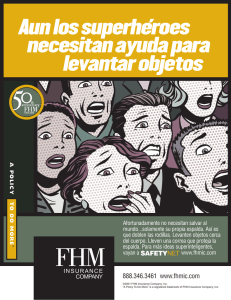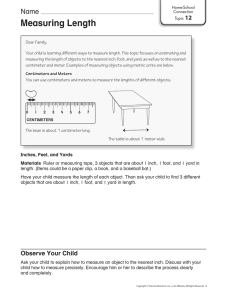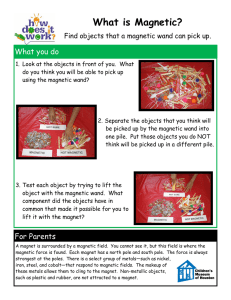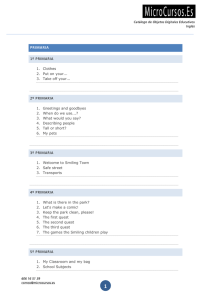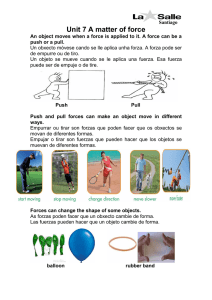Clase 3: Object detection
Anuncio
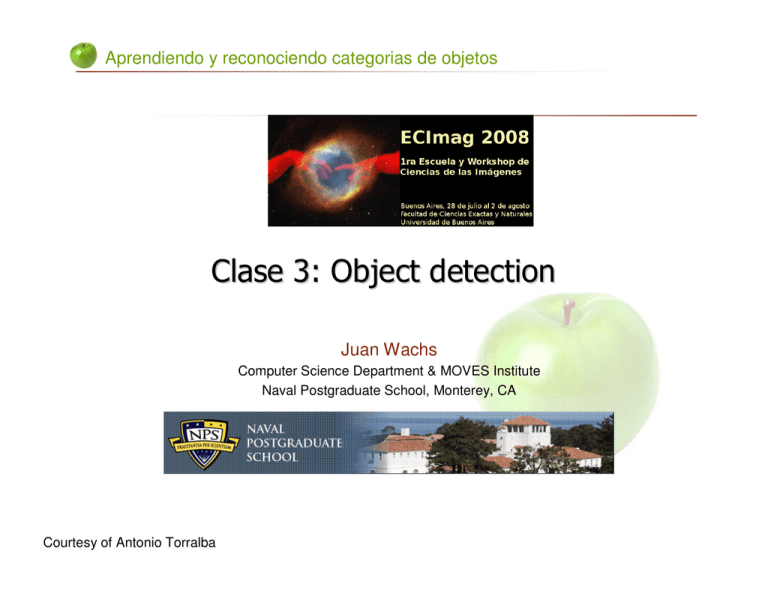
Aprendiendo y reconociendo categorias de objetos Clase 3: Object detection Juan Wachs Computer Science Department & MOVES Institute Naval Postgraduate School, Monterey, CA Courtesy of Antonio Torralba Aprendiendo y reconociendo categorias de objetos Overview of section • Object detection with classifiers • Boosting – – – – Gentle boosting Weak detectors Object model Object detection • Multiclass object detection Aprendiendo y reconociendo categorias de objetos Discriminative methods Object detection and recognition is formulated as a classification problem. The image is partitioned into a set of overlapping windows … and a decision is taken at each window about if it contains a target object or not. Background Decision boundary Where are the screens? Bag of image patches Computer screen In some feature space Aprendiendo y reconociendo categorias de objetos Formulation • Formulation: binary classification … Features x = x1 x2 x3 … xN y= -1 +1 -1 Labels -1 xN+1 xN+2 … xN+M ? Training data: each image patch is labeled as containing the object or background ? ? Test data • Classification function Where belongs to some family of functions • Minimize misclassification error (Not that simple: we need some guarantees that there will be generalization) Aprendiendo y reconociendo categorias de objetos Boosting • Defines a classifier using an additive model: Strong classifier Weak classifier Weight Features vector • We need to define a family of weak classifiers from a family of weak classifiers Aprendiendo y reconociendo categorias de objetos Overview of section • Object detection with classifiers • Boosting – – – – Gentle boosting Weak detectors Object model Object detection • Multiclass object detection Aprendiendo y reconociendo categorias de objetos The GentleBoost approach • Our cost function is an empirical average over the training data N J wse = ∑ w (zi − hm ( vi ) ) 2 m i i =1 where f f f hm ( vi ) = aδ (vi > θ ) + bδ ( vi ≤ θ ) and wim = e− zi H m −1 ( vi ) Minimizing J requires taking the derivative wrt a and then b, and equating to zero, we get: w z δ (v ∑ a= ∑ w δ (v i i i f i f i i i >θ) >θ) and b= f δ ( w z v ∑i i i i ≤ θ ) f w δ ( v ∑i i i ≤ θ ) Aprendiendo y reconociendo categorias de objetos Regression “stumps” • Lets describe the weak classifier’s parameters by a decision tree: hm ( v if ) f2 f1 θ1 a1 ,b1 θ2 a2 , b2 θ3 a3 ,b3 f3 θ4 f4 • • • • • • fK θp a4 , b4 Pick the node that minimizes the cost function Jwse a p , bp Aprendiendo y reconociendo categorias de objetos GentleBoost Pseudocode Aprendiendo y reconociendo categorias de objetos From images to features: Weak detectors We will now define a family of visual features that can be used as weak classifiers (“weak detectors”) Takes image as input and the output is binary response. The output is a weak detector. Aprendiendo y reconociendo categorias de objetos Weak detectors Textures of textures Tieu and Viola, CVPR 2000 Every combination of three filters generates a different feature This gives thousands of features. Boosting selects a sparse subset, so computations on test time are very efficient. Boosting also avoids overfitting to some extend. Aprendiendo y reconociendo categorias de objetos Weak detectors Haar filters and integral image Viola and Jones, ICCV 2001 The average intensity in the block is computed with four sums independently of the block size. Aprendiendo y reconociendo categorias de objetos Weak detectors Other weak detectors: • Carmichael, Hebert 2004 • Yuille, Snow, Nitzbert, 1998 • Amit, Geman 1998 • Papageorgiou, Poggio, 2000 • Heisele, Serre, Poggio, 2001 • Agarwal, Awan, Roth, 2004 • Schneiderman, Kanade 2004 • … Aprendiendo y reconociendo categorias de objetos Weak detectors Part based: similar to part-based generative models. We create weak detectors by using parts and voting for the object center location Car model Screen model These features are used for the detector on our course. Aprendiendo y reconociendo categorias de objetos Weak detectors First we collect a set of part templates from a set of training objects. Vidal-Naquet, Ullman (2003) … Aprendiendo y reconociendo categorias de objetos Weak detectors We now define a family of “weak detectors” as: = * = Better than chance Aprendiendo y reconociendo categorias de objetos Weak detectors We can do a better job using filtered images * = = * = Still a weak detector but better than before Aprendiendo y reconociendo categorias de objetos Training First we evaluate all the N features on all the training images. Then, we sample the feature outputs on the object center and at random locations in the background: Aprendiendo y reconociendo categorias de objetos Representation and object model Selected features for the screen detector … … 1 2 3 4 Lousy painter 10 100 Aprendiendo y reconociendo categorias de objetos Representation and object model Selected features for the car detector … … 1 2 3 4 10 100 Aprendiendo y reconociendo categorias de objetos Overview of section • Object detection with classifiers • Boosting – – – – Gentle boosting Weak detectors Object model Object detection • Multiclass object detection Aprendiendo y reconociendo categorias de objetos Feature output Example: screen detection Aprendiendo y reconociendo categorias de objetos Feature output Thresholded output Example: screen detection Weak ‘detector’ Produces many false alarms. Aprendiendo y reconociendo categorias de objetos Example: screen detection Feature output Thresholded output Strong classifier at iteration 1 Aprendiendo y reconociendo categorias de objetos Example: screen detection Feature output Thresholded output Second weak ‘detector’ Produces a different set of false alarms. Strong classifier Aprendiendo y reconociendo categorias de objetos Example: screen detection Feature output Thresholded output Strong classifier + Strong classifier at iteration 2 Aprendiendo y reconociendo categorias de objetos Example: screen detection Thresholded output Strong classifier + … Feature output Strong classifier at iteration 10 Aprendiendo y reconociendo categorias de objetos Example: screen detection Thresholded output Strong classifier + … Feature output Adding features Final classification Strong classifier at iteration 200 Aprendiendo y reconociendo categorias de objetos Demo Demo of screen and car detectors using parts, Gentle boost, and stumps: > runDetector.m Aprendiendo y reconociendo categorias de objetos Probabilistic interpretation • Generative model • Discriminative (Boosting) model. Boosting is fitting an additive logistic regression model: It can be a set of arbitrary functions of the image This provides a great flexibility, difficult to beat by current generative models. But also there is the danger of not understanding what are they really doing. Aprendiendo y reconociendo categorias de objetos Weak detectors • Generative model • Discriminative (Boosting) model. Boosting is fitting an additive logistic regression model: gi fi, Pi Image Feature Part template Relative position wrt object center Aprendiendo y reconociendo categorias de objetos Object models • Invariance: search strategy • Part based gi fi, Pi Here, invariance in translation and scale is achieved by the search strategy: the classifier is evaluated at all locations (by translating the image) and at all scales (by scaling the image in small steps). The search cost can be reduced using a cascade. Aprendiendo y reconociendo categorias de objetos Cascade of classifiers Fleuret and Geman 2001, Viola and Jones 2001 100% Precision 100 features 30 features 3 features 0% Recall 100% We want the complexity of the 3 features classifier with the performance of the 100 features classifier: Select a threshold with high recall for each stage. We increase precision using the cascade Aprendiendo y reconociendo categorias de objetos Summary of Class 3 • Object detection with classifiers • Boosting – – – – Gentle boosting Weak detectors Object model Object detection • Implementation and use
